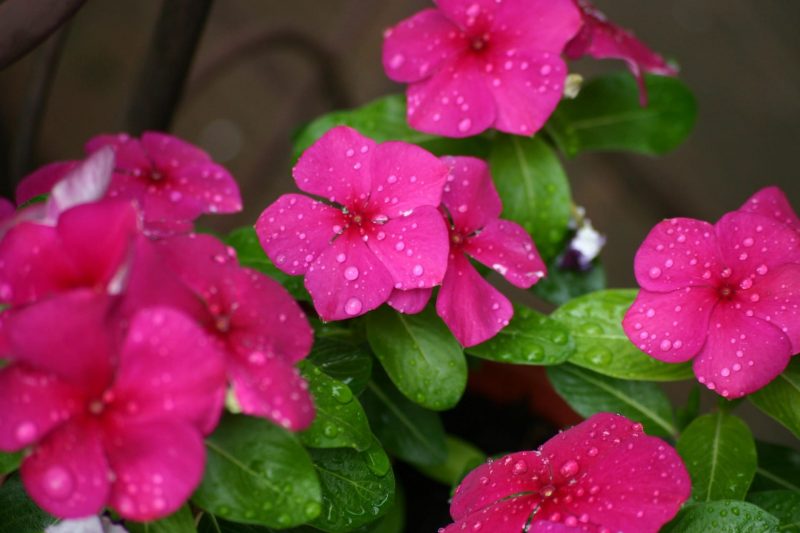There are two ways on how to propagate annual vinca, and you can either use seeds or cuttings. However, it’s worth mentioning the importance of a stable environment like the greenhouse for propagation and starting plants. Remember that while annual vincas are relatively easy to propagate, these plants’ development is more guaranteed if the environment is consistent and provides the optimal growing conditions.
And while annual vincas are synonymous with periwinkles, they are not the same with perennial vincas, Vinca minor, and Vinca major. It’s vital to keep this in mind before propagating them to distinguish some differences between the two periwinkle types.

How To Propagate Annual Vinca For Beginners
Seeds
Step #1. Collecting seeds
You can collect annual vinca seed pods before they split open, and this is when the flowers start to droop and fade. From green, the pods turn yellowish-brown, which indicates that you can pinch them off. Then, place the seedpods in a paper bag before placing it in a warm and dry location to help with drying.
Step #2. Drying seeds
Some gardeners also lay the pods in a shallow, open container and put it in direct sunlight. If you choose the former method, an excellent tip to hasten the process is by shaking the paper bag every day. Once the pods are dried, gently open them to collect the vinca seeds.
These tiny black seeds should be ready for storage in a paper envelope until planting after the frost has passed. To store annual vinca seeds, you can use the greenhouse and maintain the indoor conditions as cool and dry with adequate ventilation. This will prepare the seeds for germination and help break dormancy.
Step #3. Planting seeds
As mentioned earlier, the best time to plant annual vinca seeds is after the danger of frost has passed. Annual vinca is not cold hardy, so planting the seeds in cold conditions will cause failure. A safe bet is to use a greenhouse and sow seeds three to four months before the last frost date.
To further help with germination, lightly layer the top of the seeds with soil and place a damp newspaper over them to subject them to complete darkness. You can also adjust the greenhouse temperature at 80°F to create the optimal germination environment.
The seeds should grow within two to nine days, and at this point, they can receive sunlight and stay at 75°F.
Cuttings
You probably have an idea of how to start vinca from cuttings. As mentioned earlier, annual vinca ( Catharanthus roseus) or Madagascar periwinkle is not the same as Vinca minor and Vinca major. Annual periwinkle is easier to maintain without the need for deadheading, and it works well as a bedding plant.
Step #1. Taking cuttings
Back to the use of cuttings, you can choose the parent plant and take cuttings early in the fall. Remember to select a healthy parent plant with the qualities you like because cuttings create clones, unlike seeds. You can take semi-ripe sections or shoots that are around 4 inches long.
Step #2. Preparing cuttings
Similar to propagating other plants from cuttings, make sure to remove the lower leaves of the cutting and only leave those at the top. You can dip the end in a hormone rooting powder before planting in light compost or a mix of sand and peat compost to help with rooting. Then, use the greenhouse for the cuttings and create a highly humid and warm environment.
Step #3. Rooting and transplanting
To further help the cuttings to establish and root, cover the pot loosely with a polythene bag and maintain the greenhouse at 72 to 75°F with some shade. You can then help them get used to light gently before transferring in larger pots with potting medium.
Some gardeners also root the vinca cuttings over the winter in water, and once rooted, plant them in potting soil in late winter. They can stay indoors as nursery plants before transplanting in their permanent locations in spring.
Growing Annual Vinca
Annual vinca does well in warm seasons, so it’s best only to plant them permanently if they receive full sun, and the nighttime temperatures are around 60°F. They can survive drought but aim to soak them with water weekly and fertilize to help maintain flowers all summer. Other than this, you don’t need to deadhead them as annual vincas are self-cleaning anyway.
You might also like that Madagascar periwinkles are resistant to severe problems from pests and diseases. However, they can still suffer from rot, so ensure that you’re diligent with management practices such as watering.
Conclusion
Vincas are not limited to perennials, and if you want a bedding plant, consider annual vincas or Madagascar periwinkles. But is it easy to learn how to propagate annual vinca? Yes, and generally speaking, they have lower maintenance needs.
You can propagate annual vincas via seeds and cuttings, but either method will be more comfortable in the greenhouse. You can maintain the ideal germination conditions for the seeds, and the rooting of the cuttings is easier indoors where the environment is constant. The main takeaway with either propagation method is to avoid planting during harsh winter because annual vincas are not hardy for this condition.
